The Psychology of Color in Web Design
by Admin
Posted on 13-06-2023 09:30 AM

Color. It’s everywhere, impacting how we think, feel and behave. In web design, colors influence where we look, what we click, and how we interpret elements on a
https://vimar.ie
. So as a web designer, it’s important to understand how colors work and how to harness their power. You’re probably already aware of some basic color psychology, like red meaning danger in western culture, but how we understand color is still mostly subjective. People have personal preferences when it comes to color, usually impacted by our upbringing, experiences and events, and cultural background.
 Still, there are some common generalities and patterns around how people respond to color, which we’ll explore in this post.
Still, there are some common generalities and patterns around how people respond to color, which we’ll explore in this post.
Colour wields enormous sway over our attitudes and emotions, which is a powerful tool when it comes to ecommerce web design. While most of us know how to pair colours in everyday life, from decorating our homes to pairing an outfit – when it comes to colours in web design, it seems there’s specific psychology to it all.
Creating a color palette can be challenging. The following guidelines can help you to create a color palette: choose a color harmony (from above) and iterate on individual colors. A monochromatic scheme is typically the easiest to create and apply, so if you have zero color experience, start with this harmony. Once you settle on a harmony, switch different colors in and out to see how they work and look together until you get a winning combination that you like and that works well for your design. Don’t feel like you have to get it right the first time. If you feel stuck or just don’t know where to start, draw inspiration from existing palettes (e.
This page may contain links from our sponsors. Here’s how we make money. Web design needs to do several things at once. It must look good. It must make sure the navigation of the website is clear. It must hold an internet user’s attention for as long as possible. And it must gently lead the user down the conversion funnel, quietly urging the user to take whatever action the site owners have as the goal of the site. Because web design needs to have an influence over people’s behavior, more and more designers have been looking to the psychology of color to help them create websites.
It’s important to understand that color is interpreted differently for every person. Gender, age, and other societal considerations have a profound impact on how colors are perceived. Sometimes, it’s not always the actual color that brings out feelings; it’s about how a person feels when a specific color is used by a brand. Even personal experiences may skew someone’s opinion about a color, which is entirely out of your control. All of that being said, there have been plenty of studies conducted to give us some concrete data and trends to keep in mind. Here is a breakdown of how people commonly perceive some colors and how you can take advantage of this for your web design!.
Color Preferences for Men and Women
The first thing you need to establish is your target audience. Who is it you’re trying to engage on your website? this information will undoubtedly shape overall design of your site from colors to fonts.
 You want to make the content interesting to those you want to convert. Most businesses have a pretty good idea about their target market. For instance, beauty and skin care organizations like l’oréal don’t often target men. This particular company’s target audience is women in general. If you’re unsure about who your target audience is, using tools like google analytics can be quite helpful.
You want to make the content interesting to those you want to convert. Most businesses have a pretty good idea about their target market. For instance, beauty and skin care organizations like l’oréal don’t often target men. This particular company’s target audience is women in general. If you’re unsure about who your target audience is, using tools like google analytics can be quite helpful.